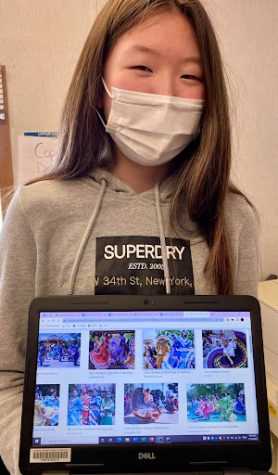A delicious Chinese New Year
As Chinese New Year is looming by, so is the iconic tradition. Enjoy the tradition by eating Chinese food, one of the most delicate cuisines in the world.
A Chinese New Year consists of hong bao (红包), which translates to lucky red bag, the horde of your whole extended family, but most importantly, food. Chinese food is one of the most iconic type of cuisine. It varies from sweet to salty, and even extremely spicy according to each province. The food on the table during the Chinese New Year celebration are delicious because these variations are present. Chinese New Year is not only a time for reunion and reflection, but the holiday of food and delicacies. With Chinese New Year looming close by, on Friday, Feb. 16, all of these iconic celebrations will be present, especially the food.
“When I think of Chinese food, the first thing that comes to mind is dumplings,” Vik, an eighth grade student says.
“I would be surprised if a Chinese New Year did not have dumplings,” Joshua, another eighth grade student said.
Dumplings are usually the present during the New Year. Another similar food present is xiao long bao (小笼包), a steamed bun. The bun is one of popular foods in China, especially in the Jiangnan (江南) and Shanghai (上海) province. The steamed bun has a thin outside layer skin made of flour with pork on the inside. The traditional form of eating xiao long bao is to scoop it into a round spoon. After eating the xiao long bao, drink the soup from the bowl that comes from the fat of the steamed pork. The rest is often eaten with grape vinegar. This steamed bun is usually served in a xiao long (小笼), a small bamboo basket, giving the dish its name.
“I eat xiao long bao a lot,” said Westin Yang, another eighth grade student, “I love the taste! The blend of the skin and the rich, freshly cooked pork against my tongue makes xiao long bao my favorite food.”
Gongbao jiding(宫保鸡丁) is another dish that often has its place on the dinner table. It is also famously known in America by the name of Kung Pao chicken.
Gongbao Jiding originated in Sichuan(四川), China; known for their spicy food. Kung Pao came about, after the dish was Americanized in Chinese restaurants into a mild dish that did not use ingredients native to China.
Gongbao Jiding has an interesting backstory. This dish is believed to be named after Ding Baozhen (丁宝桢), royalty of the Sichuan province. Baozhen loved this dish so much, the people decided to name the dish after him. Because Baozhen had the title of gongbao, the dish was named Gongbao Jiding which means chicken.
“I eat Gongbao Jiding a lot, since my mom is from Sichuan province, but I never knew this interesting story about the name of this dish,” said Adrian, a citizen of Herndon.
Xiao long bao and Gongbao Jiding are the main courses often found on authentic, Chinese menus; Chinese cuisine also has deserts that are mouthwatering. Just like Gongbao Jiding, tang yuan(汤圆) is an iconic name. Tang yuan’s special name was given during the Ming Dynasty. The official name in northern China is yuan xiao(元宵), which comes from Yuan Xiao festival. Yuan xiao’s literal meaning is first evening. This is referring to the first full moon after Chinese New Year, when this dish is often consumed.
In southern China, yuan xiao is referred to the more common tang yuan. Legend has it, that Yuan Shikai(袁世凱), a Chinese emperor, didn’t like the name yuan xiao, because it sounded identical to remove yuan. As a result, he gave orders to change the name to tang yuan, which literally means sweet dumplings, and it lives up to its definition.
Tang yuan has a white outer ball, made from flour, and a sweet. filling inside. The filling can be a variety of different ingredients, but the most common is sesame paste. The little dough balls are white and float in warm sweetwater. They are eaten by scooping them up with spoons and then bitten through a chewy skin to create a rush of sweet, delicate sesame paste.
These are only a few of the many dishes that may be present during Chinese New Year. On the table, you may find many different types of dishes. On one side of the table, you may find extremely spicy meals, and on the other side, sweetened dishes that cool down the spice. All these different types of food make each bite a savoring experience.
“Chinese New Year comes once a year, but the thought of the food comes every day,” said Westin.
As every holiday has its unique dishes they serve up, Chinese New Year’s cuisine stands out as both unique and delicious. It brings together family in reunion and it the talk of the days after. Food is an important part of representation of Chinese culture, and every culture, a common language spoken with our taste buds. Biting into a xiao long bao shows a part of the legacy and culture of Chinese New Year.
Recipes:
Xiaolongbao (小龙包) Recipe:
Ingredients: To cook this dish, it requires a wrap, made of flour, usually found at a supermarket. There are different ingredients that will go inside the wrap. Commonly, ground pork is used, but there are also a variety of other fillings
- First, take the ground pork, and cut it into small pieces. Put these cut pieces into a seperate bowl
- Now, we can make the dumpling. Take one wrap, and put it on a flat surface
- Now, put a small handful of pork into the wrap. Make sure the pork does not go on the edge of the wrap
- When your done with this, put water on your finger and trace around the edge of the wrap
- Then fold the wrap so the edges will meet each other. The water will act as a glue to connect the edges
- Fold again the other way
- Finally, put the dumplings in a steamer
- Eat after a few minutes of steaming
Gongbao Jiding (宫保鸡丁)Recipe:
Ingredients: The main ingredients are boneless chicken cut into edible pieces, sauteed with peanuts, as well vegetables, chili peppers, Sichuan peppers, garlic, and scallions, cooked with cornstarch, peanut oil, and soy sauce.
- First combine the chicken, cornstarch and soy sauce in a small bowl.
- With all the ingredients in the bowl, you then toss the chicken until it’s well-coated in the mixture.
- Now set those ingredients aside. Meanwhile, heat a large, pan over medium heat.
- Add the peanuts and cook, while gently tossing occasionally, until the peanuts are golden brown and fragrant. This may take 2-3 minutes.
- After, transfer the peanuts to a bowl to cool down.
- Next, heat the peanut oil in the pan over medium-high heat until it starts to shimmer.
- Add the Sichuan peppers and chiles and cook, stirring continuously, until the chiles turn a light brown in color.
- Then, turn the heat to high and add the marinated chicken that we originally set aside.
- Cook for 2-3 minutes, until the chicken starts to turn golden, then add the garlic, ginger, scallions, and peanuts.
- Continue cooking until the chicken is cooked thoroughly. This may take 1-2 more minutes.
- Turn off the heat and serve it, usually with traditional white rice.
Tangyuan (汤圆) Recipe:
Ingredients: To make tang yuan, you will need roasted black sesame seeds, sugar, sweet rice flour, butter and warm water.
- First, you will need to grind the the sesame seeds in a blender.
- Add sugar and mix.
- When completely mixed, add the butter and pulse for ten seconds.
- Now scoop the mix out and put it in the refrigerator for 30 minutes; this is our filling.
- Now, mix the rice flour with the hot water to make the dough.
- Take pieces of the dough, and form them into small bowl shapes.
- Now take the filling out of the refrigerator. Take some filling, and put it into the dough you just shaped.
- Seal the dough.
- Put it into boiled water, and eat after 5-6 minutes.



